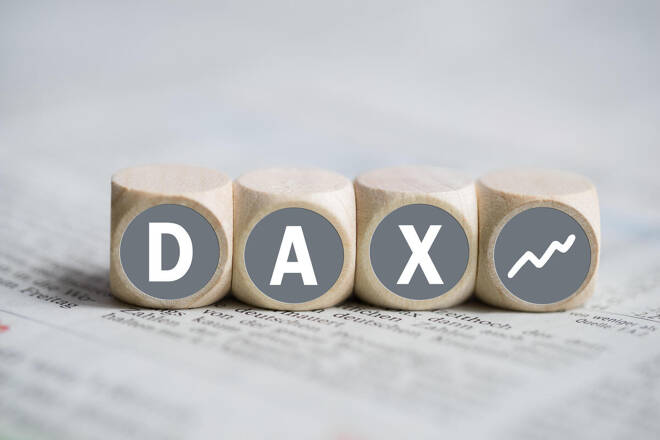Advertisement
Advertisement
Dax Index: Soaring Rates and Slipping Stocks – Dax’s Tightrope
By:
Explore how DAX 30 navigates market sentiments, balancing ECB monetary policies and German consumer confidence, amid fluctuations in Dax stocks and global influences.
Highlights
- The DAX fell by 0.25% on Wednesday, with recessionary fears weighing on buyer appetite.
- Elevated ECB rates led to an 11.9% slump in overnight deposits; term deposits rose in August.
- Market eyes on upcoming German inflation data; softer figures could ease ECB pressure.
DAX Wednesday Overview
On Wednesday, the DAX slipped by 0.25%. Following a 0.97% slide on Tuesday, the DAX ended the day at 15,218.
Bets on Higher-for-Longer Rates Reversed Early Gains
Industrial profit numbers from China supported a positive start to the mid-week session. However, weaker consumer confidence numbers from Germany weighed on buyer appetite. The influential German GfK Consumer Climate indicator fell from -25.6 to -26.5 for October.
Notably, the propensity to save increased despite income expectations steadying. The consumer propensity to save signaled a pullback in consumer spending, further impacting the German services sector.
Market sentiment toward ECB monetary policy goals continued to test buyer appetite. Investor bets on the ECB keeping interest rates higher for a prolonged period remained a headwind.
ECB money supply and lending statistics also influenced investor sentiment.
Significantly, overnight deposits slumped by 11.9% in August. The higher interest rate environment diverted depositors to term deposit products, impacting money supply, a leading indicator for a recession.
The slump in money supply and a curb on bank lending added to the gloomy mood. The latest numbers from the ECB showed a modest 1.0% increase in private sector loans in August versus 1.3% in July.
US economic indicators fueled a late pick up in US Treasury yields. Core durable goods orders beat forecasts, supporting the more hawkish Fed interest rate path. Fed uncertainty delivered a mixed session for the US equity markets.
On Wednesday, the NASDAQ Composite Index and the S&P 500 saw gains of 0.22% and 0.02%. The Dow declined by 0.20%.
The Wednesday Market Movers
Siemens AG and Siemens Energy AG were among the front runners, gaining 3.29% and 2.27%, respectively. Dip buyers jumped in after heavy losses in recent sessions.
Bank stocks were also higher, with Deutsche Bank and Commerzbank rising by 2.42% and 0.84%, respectively.
However, Daimler Trucking was among the worst performers, sliding by 2.50%.
German Inflation and the ECB Economic Bulletin in Focus
German inflation figures for September will draw investor interest later today. Softer inflation figures may ease investor jitters over a higher-for-longer ECB interest rate path.
Economists forecast the German annual inflation rate to soften from 6.1% to 4.6%. However, the numbers may need fall below sub-4% to materially ease pressure on the ECB from keeping rates elevated.
Ahead of the inflation numbers, the ECB Economic Bulletin also needs consideration. ECB views on the economy, inflation, and monetary policy will influence buyer appetite.
Investors must also monitor ECB commentary. ECB Executive Board members Andrea Enria and Elizabeth McCaul are on the calendar to speak today. A shift from the higher-for-longer script may ease selling pressure.
US Jobless Claims in Focus
US labor market numbers will be in focus later today. Another unexpected fall in jobless claims would fuel bets on a December Fed rate hike. Economists forecast initial jobless claims to increase from 201k to 215k. The markets will likely consider sub-220k acceptable to support the hawkish Fed interest rate path.
Second-quarter US GDP numbers are also due out but will likely play second fiddle to the labor market numbers.
The DAX and NASDAQ mini were up 30 and 0.5 points this morning. However, it could be a testy session for the DAX. Government bond yields will need tracking throughout the session. 10-year US Treasury yields climbed higher this morning before easing back.
Short-Term Forecast
Softer German inflation numbers would ease selling pressure. However, elevated US Treasury yields on a more hawkish Fed rate path remain a headwind. Movement over the remainder of the week hinges on US jobless claims and US inflation and consumption numbers tomorrow.
DAX Technical Indicators
Daily Chart
The DAX sat below the 50-day and 200-day EMAs, affirming bearish price signals. A fall below 15,200 would support a DAX move to the 15,058 support level. Lower-than-forecast US jobless claims, and hotter-than-predicted German inflation would impact risk appetite.
However, a break above the 15,245 resistance level would bring the 15,459 resistance level and 200-day EMA into view.
The 14-Daily RSI reading of 31.21 supports a DAX fall below 15,200 support level before entering oversold territory.
4-Hourly Chart
The DAX, sitting below the 50-day and 200-day EMAs, reaffirms bearish price signals. A DAX break above the 15,245 resistance level would support a move toward the 15,459 resistance level.
However, a fall below 15,200 would give the bears a run at the 15,058 support level.
The 26.65 RSI reading indicates the DAX is in the oversold territory.
For a look at the economic events, check out our economic calendar.
About the Author
Bob Masonauthor
With over 28 years of experience in the financial industry, Bob has worked with various global rating agencies and multinational banks. Currently he is covering currencies, commodities, alternative asset classes and global equities, focusing mostly on European and Asian markets.
Did you find this article useful?
Latest news and analysis
Advertisement
